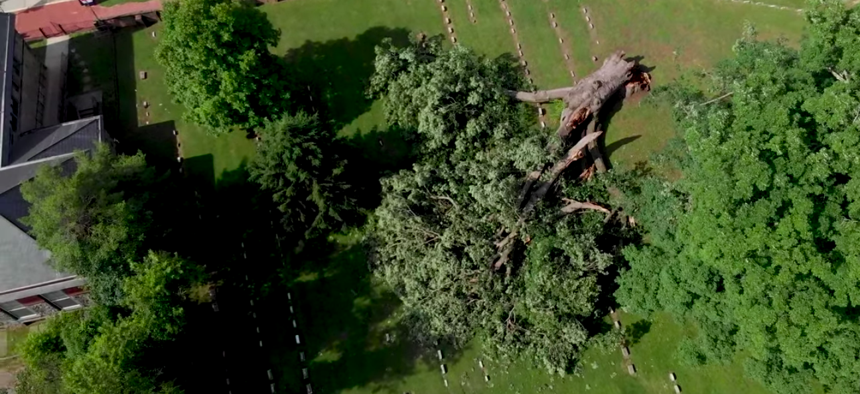Planting a Family of Trees, One Seedling at a Time

The state said the white oak died from "severe rot," and noted the tree was nearly twice as old as the normal lifespan for its species. New Jersey Department of Environmental Protection
A 600-year-old tree fell in New Jersey. Officials will preserve its legacy by sending its seedlings all over the state.
Every New Jersey municipality will receive seedlings from a nearly 600-year-old oak tree that died unexpectedly in June, an effort by state environment officials to ensure the oak’s legacy.
“Fifty years from now, people will know that our shared commitment to protecting and respecting our environment ran as deep as the roots of the mighty Salem Oak," Catherine R. McCabe, commissioner of the state’s Department of Environmental Protection (DEP), said in a video that aired during a mayors’ luncheon at the New Jersey League of Municipalities convention last week.
The Salem Oak stood in a small Quaker burial ground on West Broadway in Salem, New Jersey, for more than 500 years before suddenly crashing to the ground on June 6. The white oak was among the state’s largest, standing more than 100 feet tall with a trunk circumference of roughly 22 feet. "Severe rot" was the official cause of death, according to DEP, which also noted that the tree's age “exceeded the lifespan of most white oaks, which typically live 200 to 300 years.”
The Salem Oak was one of “New Jersey’s best-known and most celebrated trees,” the department said. It was the lone surviving tree from the original forest that covered the land when Quaker John Fenwick, Salem’s founder, arrived in the area in 1675. According to local lore, Fenwick met with Lenni Lenape Native Americans and signed a peace treaty under the tree, an event commemorated on the site by a historical marker.

Foresters from the department’s Big and Heritage Tree Conservation program had collected acorns from the base of the tree months before its demise and “saw no evidence that the tree’s days were numbered,” according to a news release. Those acorns produced nearly 1,200 seedlings, which were transferred to tubes and are now being cared for in a greenhouse at one of the state Forest Service’s nurseries.
The seedlings will be shipped to each of the state’s 565 municipalities for planting in April. Each seedling will come with a certificate of authenticity that proclaims its heritage. The Department of Environmental Protection is preparing a video with planting instructions and is also planning a special website for municipalities to share details of their plantings.

New Jersey has dabbled in statewide seedling distribution before. In 2012, Superstorm Sandy swept across the state and destroyed thousands of trees, prompting the Arbor Day Foundation and the New Jersey Forestry Service to launch the New Jersey Tree Recovery Campaign, which provides free seedlings to residents and communities across the state. To date, nearly 333,000 trees have been distributed via the program, according to the campaign’s website.
“Superstorm Sandy’s winds toppled a staggering number of trees in towns across the state, and not just the counties that were hardest hit by the storm,” Bob Martin, then the commissioner of the Department of Environmental Protection, said in a statement in 2014. “Through this campaign, residents can replant trees where it means the most to them—right in their backyard.”
Distribution of the Salem Oak seedlings will be timed to coincide with the 50th anniversary of both Earth Day and the state Department of Environmental Protection, as well as with Arbor Day.
Seedlings from the Salem Oak have also been planted in other places, including along the George Washington Memorial Parkway in Washington, D.C.
Kate Elizabeth Queram is a Staff Correspondent at Route Fifty.
NEXT STORY: Mayors Ask Trump Administration to Scrap Plan to Let Cities and States Block Refugees





